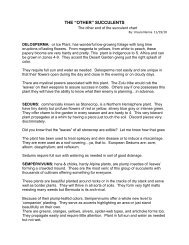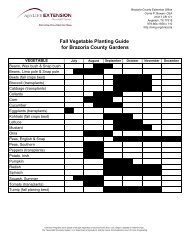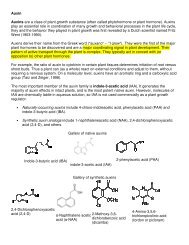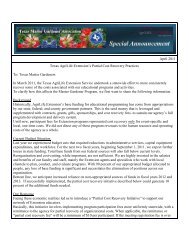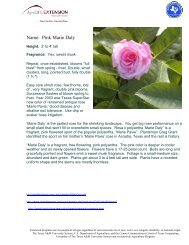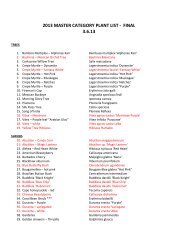Graywater - Texas Master Gardeners Association
Graywater - Texas Master Gardeners Association
Graywater - Texas Master Gardeners Association
Create successful ePaper yourself
Turn your PDF publications into a flip-book with our unique Google optimized e-Paper software.
y plants then percolates through the<br />
soil profile. The soil provides water<br />
treatment through physical (filtration),<br />
chemical (adsorption and transformation)<br />
and biological (degradation and<br />
predation) processes to kill off harmful<br />
pathogens.<br />
<strong>Graywater</strong> systems equipped<br />
with pump tanks can disperse water<br />
through a pressurized subsurface drip<br />
system to irrigate trees, flowerbeds<br />
and planter boxes (Fig. 10). If graywater<br />
will be used for irrigation, it is<br />
important to know how much water<br />
will be available for reuse, so that the<br />
irrigation system can be sized accordingly.<br />
Reuse system design also<br />
should consider typical supplemental<br />
water requirements of plants, especially<br />
during peak water-use months.<br />
<strong>Graywater</strong> reuse alone may not be sufficient<br />
to meet plant peak-water needs<br />
for high-water-use lawns, but it may<br />
provide enough water for small flower<br />
beds and planter boxes.<br />
An in-line filter should be installed<br />
to remove any particulate matter that<br />
might clog discharge pipes or irrigation<br />
emitters. The filter type needed<br />
depends upon amount of graywater to<br />
be filtered and types of contaminants<br />
expected. No matter what filter type is<br />
used, it should be cleaned periodically<br />
in order to prevent it from clogging<br />
or reducing flow to irrigation fields.<br />
Automatic backwashing filters are<br />
available and can limit clogging risks.<br />
Regulations regarding graywater<br />
systems do not provide specific guidance<br />
on distribution-system sizes,<br />
so designers can size a system based<br />
either on irrigation requirements or on<br />
soil absorption.<br />
If system size is based on irrigation<br />
requirements, distribution areas must<br />
be designed to meet summer-month<br />
water requirements for landscape<br />
plants. During winter (or in lowerwater-use<br />
months), graywater must be<br />
diverted to an onsite wastewater treatment<br />
system or a municipal sewer to<br />
prevent oversaturating the soil, resulting<br />
in less treatment of the graywater.<br />
Distribution-system sizing based on<br />
soil-absorption requirements may not<br />
Figure 10. <strong>Graywater</strong> system using pressurized distribution in a subsurface drip system.



